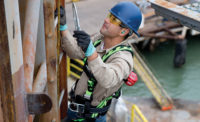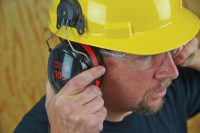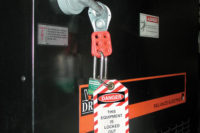When your workplace is noisy, your first reaction is to have affected employees wear hearing protection devices (HPDs). But you need details on each employee’s exposure and the effectiveness of the HPD you provide before you can know for certain that each worker is protected.
Noise monitoring
It’s time to conduct noise monitoring if normal conversation is difficult because of the noise, employees complain about the loudness of the work area, or something indicates that employees are losing their hearing.
Whether you use dosimeters to conduct personal noise monitoring or sound level meters to create “noise maps,” the goal of noise monitoring is to identify those employees who are exposed to noise at a level equal to or exceeding an 8-hour time-weighted average (TWA) exposure of 85 decibels (dB). Under OSHA standard 1910.95, this exposure is called the “action level” and is equivalent to a dose of noise that is half of the 8-hour TWA permissible exposure limit (PEL) of 90 dB.
Be sure to let employees observe the monitoring and give individual employees their monitoring results if they’re exposed at or above this action level.
Providing HPDs
Aside from identifying employees to include in your hearing conservation program, your noise monitoring results help you make decisions about HPDs.
You must make HPDs available to all employees exposed at or above the action level (at no cost to the employees). You must require each employee exposed above the 8-hour TWA PEL of 90 dB to wear the HPDs.
HPDs are also required to be worn by any employee who is exposed at or above the action level and has not yet had his or her baseline audiogram established.
In addition, you must require HPDs to be worn by any employee who, based on the results of annual audiometric testing, experiences a standard threshold shift (STS). An STS, determined from the results of annual audiograms, is a change in hearing threshold relative to the baseline audiogram of an average of 10 dB or more at 2000, 3000, and 4000 Hz in either ear.
OSHA expects employers to offer each affected employee a choice of at least one type of earplug and one type of ear muff; however, the agency expects the employee’s selection to be “suitable” in that they not only adequately protect the worker’s hearing but are comfortable to wear. You may need to provide more than one type of earplug or ear muff so that an employee can select protection that he finds comfortable. Each person’s ear canal is different. Ear plug (and ear muff) manufacturers offer products in different sizes, shapes, and materials to fill the need for comfortable protectors.
HPD attenuation
The HPDs must effectively reduce the noise reaching the worker’s ears to a level that is at or below the 8-hour TWA PEL of 90 dB. For employees who have experienced an STS, hearing protector attenuation must be sufficient to reduce employee exposure to an 8-hour TWA of 85 dB, or below.
A common method of estimating how much the HPD will reduce the noise is to use the EPA’s Noise Reduction Rating (NRR) value that must show on the HPD’s packaging.
Because HPDs in actual use typically provide less protection than indicated in a laboratory testing environment, OSHA takes a cautious approach to using NRR values.
Using mandatory Appendix B to §1910.95, you are to first obtain the employee’s 8-hour TWA exposure level (using an A-weighted dosimeter or sound level meter). Next, subtract 7 dB from the HPD’s NRR value, and subtract the remainder from the employee’s 8-hour TWA exposure level to obtain the estimated 8-hour TWA exposure under the ear protector.
To adjust for workplace conditions, OSHA strongly recommends applying a 50 percent correction factor when estimating field attenuation. This is especially important when considering whether engineering controls are to be implemented. When you do this, the estimated exposure = TWA - [(NRR - 7) x 50%]
For example, an employee is exposed at an 8-hour TWA of 95 dB, and his ear plugs have an NRR value of 30. The estimated exposure is: 95 - [(30-7) x 0.5] or 95 - (23 x 0.5) or 95 - 11.5 or 83.5 dB. In this example, the ear plugs reduce the employee’s exposure from 95 dB to 83.5 dB. The ear plugs actually reduce the exposure by 11.5 dB, not the NRR value of 30. The ear plugs provide adequate protection because they reduce the employee’s exposure to a level that is well below OSHA’s PEL.
Dual HPD protection
When the noise is excessive, you may think that adding ear muffs over earplugs will provide twice the protection as ear plugs alone, but this isn’t the case. In practice, the extra HPD reduces the exposure by only 5 dB.
OSHA does not specify when double hearing protection is needed. The noise standard does not have additional requirements for hearing protectors when any certain peak noise levels are reached. It’s up to the employer to determine if dual protection is appropriate.
Here’s a sample calculation when dual protection is used. An employee’s 8-hour TWA exposure is 110 dB. He is wearing earplugs with an NRR value of 29 and ear muffs having an NRR value of 25.
To calculate the attenuation, first calculate field adjusted NRR for the better protector. In this case it’s the earplugs. Using the same formula from the previous example, you have: [(29 -7) x 0.5] = 11 dB. Next, add 5 dB to this field-adjusted NRR. You have 11 + 5 = 16 dB. Finally, subtract the attenuation value from the employees 8-hour TWA exposure, or: 110 -16 dB = 94 dB.
In this example, the protected 8-hour TWA is 94 dB. This hearing protection is not adequate, and better hearing protection must be used. If feasible, engineering controls must be implemented.
Follow-up
You don’t have to re-evaluate your HPD selections or fit HPDs on any set schedule. However, the adequacy of hearing protector attenuation is to be re-evaluated whenever employee noise exposures increase to the extent that your HPDs may no longer provide adequate attenuation.
In addition to keeping track of the workplace noise level, you must conduct annual training. The session is to include information on the purpose of hearing protectors; the advantages, disadvantages, and attenuation of various types; and instructions on selection, fitting, use, and care. Take this opportunity to find out if any employees are having problems with their HPDs, and check to be certain your workers are wearing the HPDs correctly.



